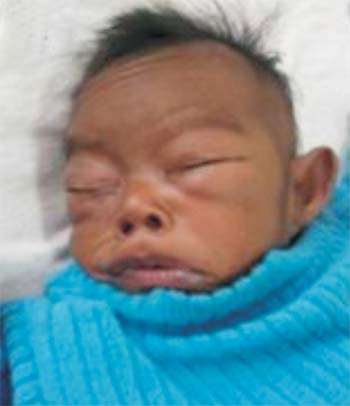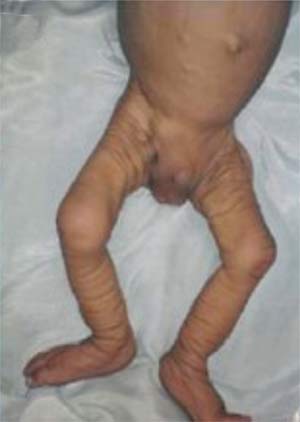|
|
|
Indian Pediatr 2012;49: 771 |
 |
Congenital Cutis Laxa
|
|
Manish Kumar and Raghvendra Singh
Department of Pediatrics, Chacha Nehru Bal Chikitsalaya
(Affiliated with Maulana Azad Medical College),
Geeta Colony, Delhi 110 031, India.
Email: [email protected]
|
A four-month-old male child presented with history of
repeated episodes of fever, cough and fast breathing since
early neonatal period. He had old man like facies with puffy
eyes, prominent easily stretchable ears and everted nostril.
Skin was loose and redundant, most marked over both the
lower limbs. There was small paraumbilical hernia, left
inguinal hernia and micropenis (Fig.1).
Abdomen was soft and distended with hepatosplenomegaly
(liver 3 cm and spleen 2 cm below subcostal margin).
Anteroposterior diameter of the chest was increased with
bilateral crepitations and rhonchi on auscultation. Weight
of the child was 3.6 kg (< 5
th
percentile), length- 53 cm (< 3rd
percentile) and head circumference- 35.8 cm. X-ray
chest revealed bilateral emphysematous lungs. Based on
clinical and radiological features, a diagnosis of
congenital cutis laxa was made.

(a) |

(b) |
|
Fig. 1 (a) Senile appearance of the
face, puffy eyes and everted nostrils; (b) Loose
skin folds over lower limbs, small paraumbilical
hernia, right inguinal hernia and micropenis.
|
Congenital cutis laxa is a rare
hereditary connective tissue disorder resulting from
abnormality of elastin fibres. It is characterized by loose,
redundant skin all over body associated with other extra
cutaneous manifestations in form of inguinal and umbilical
hernia, pulmonary emphysema, gastrointestinal and bladder
wall diverticulae and pulmonary artery branch stenosis. Our
patient probably had type I autosomal recessive variant of
cutis laxa. Absence of similar type of illness in other
family members rules out the possibility of autosomal
dominant type. The condition needs to be differentiated from
Ehlers-Danlos Syndrome, where skin is hyperextensible and
joints are hypermobile. Other condition with cutis laxa like
skin changes is Costello syndrome which can be
differentiated by presence of hyperkeratotic changes of
palms and soles, abnormally flexible finger joints and
presence of papillomata around mouth and nostrils. Absence
of joint laxity rules out the possibility of type II
congenital cutis laxa and Ehlers- Danlos Syndrome. There is
no specific treatment for this condition. Prognosis of type
I congenital cutis laxa is bad and majority of children die
in early childhood due to pulmonary or cardiovascular
complications.
|
|
|
 |
|

